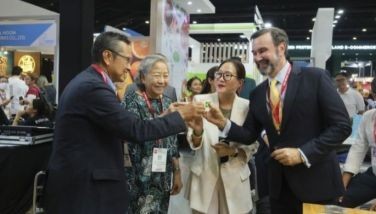Seeking the real Jesus
March 13, 2006 | 12:00am
A 3-volume work has been published by Father Carlos Abesamis S.J. entitled Backpack of a Jesus Seeker. It is attractively printed in large type, illustrated by many drawings. Written in dialogue form, the main intent of the book is to seek to know the real Jesus. It is claimed that for two thousand years we have been looking at Jesus one way (which he admits is valid) but that a "third look" is needed. To know the real Jesus we must see him through the prism of the Third World, through the eyes of the poor.
This is of course a good and holy intent, but in fact the knowledge of Jesus thus arrived at could also be obtained by simply reading carefully and prayerfully the Gospel narrative. All we really know about Jesus is in the Gospels. Anything beyond is conjecture.
An important feature of this 3-volume book is the concern for the poor and the marginalized. This is given striking expression in Book Two. If you are in a car going through the city streets and the car stops at an intersection, what do you see from the side of the car? The answer given: "thousands of street children, dirty, malnourished, risking their young lives to earn the next meal for themselves and their jobless parents."
That is a sight that those living in Malacañang or those getting millions in allowances in Congress never seem to see. Yet that is the real picture of the Philippines. This is a country where the millions of poor people have only two things to hope for: either land a job in some foreign country, or win the lottery. Here there are no jobs. Only rising prices because of government taxes.
Unless those in Malacañang and those in Congress can see the thousands of street children and understand what that implies, this country is doomed.
Father Abesamis is at the Loyola House of Studies on the Ateneo Campus, Loyola Heights, P. O. Box 257, U.P. Post Office, 1144 Quezon City.
Macario Tiu, who has already published a book on Davao history, has written another entitled Davao: Reconstructing History from Text and Memory. It is published for the Mindanao Coalition of Development NGOs by the Center for Research and Publication of the Ateneo de Davao. Of the five sections into which the book is divided, the first is on highlights of Davao history. The second, much longer, is on the tribes that were the aboriginal population: 18 tribal groups are mentioned. The third section is on the settlers, first by period (the Spanish, the American), then by nationality (Chinese, American, Japanese, deportees, etc.). The fourth section is on individuals called "heroes". And the fifth, on myths and legends. From that organization of material, one can see that this is one of the more informative books on the Davao region.
What happened at the Ateneo de Manila during the first ten years under martial law (1972-1982)? That is the subject of a book entitled Down from the Hill, published by the Ateneo University Press. It is a compilation of 7 articles by as many authors. The topics: student activism; leftist and underground organizations; faculty, administration, concerned professionals; the political climate of the 1970s; etc. There are several appendices, among them a list of Ateneans imprisoned under martial law. I would suggest adding the name of Mr. Maximo Soliven, an Atenean (high school and college) who was among those rounded up at the very start of martial law.
This is of course a good and holy intent, but in fact the knowledge of Jesus thus arrived at could also be obtained by simply reading carefully and prayerfully the Gospel narrative. All we really know about Jesus is in the Gospels. Anything beyond is conjecture.
An important feature of this 3-volume book is the concern for the poor and the marginalized. This is given striking expression in Book Two. If you are in a car going through the city streets and the car stops at an intersection, what do you see from the side of the car? The answer given: "thousands of street children, dirty, malnourished, risking their young lives to earn the next meal for themselves and their jobless parents."
That is a sight that those living in Malacañang or those getting millions in allowances in Congress never seem to see. Yet that is the real picture of the Philippines. This is a country where the millions of poor people have only two things to hope for: either land a job in some foreign country, or win the lottery. Here there are no jobs. Only rising prices because of government taxes.
Unless those in Malacañang and those in Congress can see the thousands of street children and understand what that implies, this country is doomed.
Father Abesamis is at the Loyola House of Studies on the Ateneo Campus, Loyola Heights, P. O. Box 257, U.P. Post Office, 1144 Quezon City.
Macario Tiu, who has already published a book on Davao history, has written another entitled Davao: Reconstructing History from Text and Memory. It is published for the Mindanao Coalition of Development NGOs by the Center for Research and Publication of the Ateneo de Davao. Of the five sections into which the book is divided, the first is on highlights of Davao history. The second, much longer, is on the tribes that were the aboriginal population: 18 tribal groups are mentioned. The third section is on the settlers, first by period (the Spanish, the American), then by nationality (Chinese, American, Japanese, deportees, etc.). The fourth section is on individuals called "heroes". And the fifth, on myths and legends. From that organization of material, one can see that this is one of the more informative books on the Davao region.
What happened at the Ateneo de Manila during the first ten years under martial law (1972-1982)? That is the subject of a book entitled Down from the Hill, published by the Ateneo University Press. It is a compilation of 7 articles by as many authors. The topics: student activism; leftist and underground organizations; faculty, administration, concerned professionals; the political climate of the 1970s; etc. There are several appendices, among them a list of Ateneans imprisoned under martial law. I would suggest adding the name of Mr. Maximo Soliven, an Atenean (high school and college) who was among those rounded up at the very start of martial law.
BrandSpace Articles
<
>
- Latest
- Trending
Trending
Latest
Latest
Recommended

May 20, 2024 - 4:01pm



























